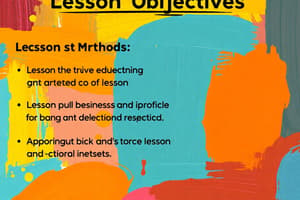Podcast
Questions and Answers
सार क्या है और यह क्यों महत्वपूर्ण है?
सार क्या है और यह क्यों महत्वपूर्ण है?
सार एक छोटा अवलोकन है जो कक्षा के दौरान प्रस्तुत महत्वपूर्ण जानकारी का संक्षेप होता है।
सार क्यों छात्रों के लिए महत्वपूर्ण है?
सार क्यों छात्रों के लिए महत्वपूर्ण है?
सार करने से छात्रों को प्रमुख विचारों पर ध्यान केंद्रित करने में मदद मिलती है और उनके लिए ज्ञान को समझना और याद रखना आसान हो जाता है।
सार क्यों भविष्य के शिक्षण अनुभवों के संदर्भ में महत्वपूर्ण है?
सार क्यों भविष्य के शिक्षण अनुभवों के संदर्भ में महत्वपूर्ण है?
सार भविष्य के शिक्षण अनुभवों के संदर्भ को प्रदान करता है और छात्रों को आगे बढ़ने के लिए मदद करता है।
सार कैसे छात्रों की भूलकर रखने में मदद करता है?
सार कैसे छात्रों की भूलकर रखने में मदद करता है?
सार क्यों होमवर्क के भाग के रूप में महत्वपूर्ण है?
सार क्यों होमवर्क के भाग के रूप में महत्वपूर्ण है?
सार क्या है और इसका उद्देश्य क्या है?
सार क्या है और इसका उद्देश्य क्या है?
Flashcards are hidden until you start studying
Study Notes
Lessons and Summary
A lesson is a form of instruction designed to convey information, skills, or values to students through classroom activities such as lectures, discussions, assignments, experiments, or demonstrations. A lesson can cover various subjects from history to mathematics, science, literature, art, music, and physical education. The main goal of a lesson is to help students learn something new or review previously learned material.
The structure of a typical lesson consists of four parts: the introduction, which presents the subject matter; the development, where concepts are explained further; the practice stage, during which students apply what they have learned; and the conclusion, when the teacher reviews the key points covered in the session.
Lessons often involve summaries, which are brief overviews of the important information presented during a class period. Summarizing helps students focus their attention on critical elements by highlighting essential ideas while omitting extraneous details. This makes it easier for them to understand what they've learned so far and provides context for future learning experiences. Teachers may also require students to create written summaries as part of their homework assignments. These exercises reinforce comprehension and help students retain knowledge more effectively.
In some cases, lessons might involve hands-on work like lab reports, journal entries, essays, projects, tests, quizzes, and presentations. Regardless of format, all lessons strive to impart understanding and promote retention of information. Effective teaching strategies involve engaging multiple senses, making connections between old and new knowledge, allowing ample time for consolidating learning, providing frequent feedback, and encouraging active participation among students.
Overall, lessons serve as tools for transmitting knowledge and helping individuals grow intellectually while preparing them for real-life situations. By following established guidelines, teachers can optimize the delivery of meaningful content within each lesson. Incorporating effective summarization techniques into lesson plans facilitates student comprehension and enhances overall learning experience.
Studying That Suits You
Use AI to generate personalized quizzes and flashcards to suit your learning preferences.




